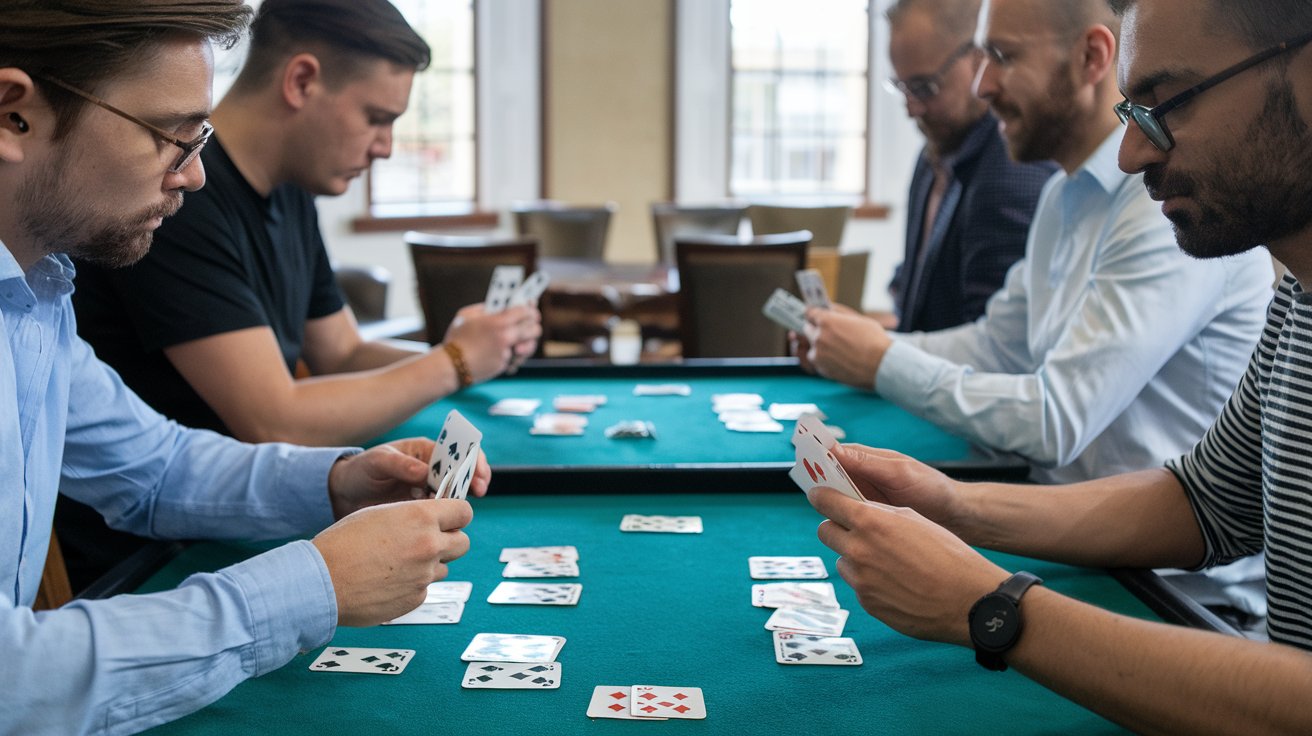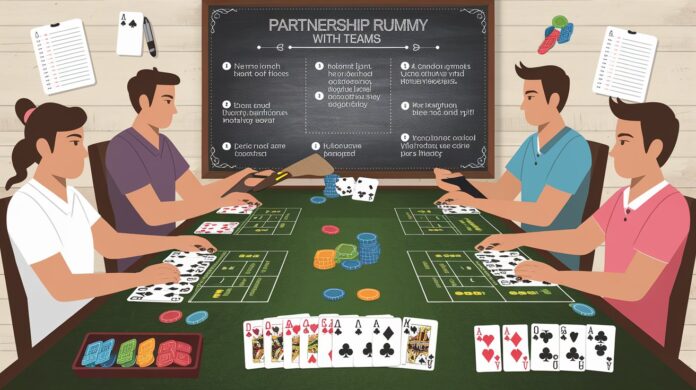Partnership rummy brings a thrilling cooperative twist to the classic card game we all know and love. Instead of playing as individuals, players team up to create strategies, share victories, and tackle challenges together. Whether you’re planning a game night with friends or looking to add some variety to your card game repertoire, partnership rummy offers an exciting social experience that combines skill, strategy, and teamwork.
In this comprehensive guide, we’ll walk you through everything you need to know about playing partnership rummy with teams – from basic setup and rules to advanced strategies that will help your team come out on top.
What is Partnership Rummy?

Partnership rummy is a variant of the traditional rummy game where players form teams (typically pairs) and work together to create melds, manage their hands, and ultimately win the game. Unlike standard rummy where it’s every player for themselves, partnership rummy requires communication, coordination, and shared strategy between teammates.
The beauty of partnership rummy lies in its social dynamics. You’ll need to understand your partner’s playing style, develop subtle communication methods, and make decisions that benefit the team rather than just your individual hand.
Getting Started: The Basics
Equipment Needed
Before diving into gameplay, make sure you have the following:
- 2-3 standard decks of cards (including jokers), depending on the number of players
- Score sheet and pencil
- Chips or counters (optional, for betting variants)
- A large table with enough space for all players
Team Formation
Partnership rummy works best with an even number of players, typically 4 or 6 players forming 2 or 3 teams respectively. Partners should sit opposite each other around the table so that the play alternates between teams.
For a 4-player game (2 teams):
- Team A: Players 1 and 3
- Team B: Players 2 and 4
For a 6-player game (3 teams):
- Team A: Players 1 and 4
- Team B: Players 2 and 5
- Team C: Players 3 and 6
Card Distribution
The number of cards dealt depends on the number of players and the specific variant you’re playing, but a common distribution is:
- For 4 players: 13 cards per player
- For 6 players: 10 cards per player
The remaining cards form the stock pile, with the top card turned face up to start the discard pile.
Basic Rules of Partnership Rummy
Objective
The goal in partnership rummy is for your team to be the first to arrange all cards in your hands into valid sets and sequences and then go out by discarding your final card.
Valid Combinations
Just like in standard rummy, you’ll need to form:
- Sets: Three or four cards of the same rank but different suits
- Example: 8 of hearts, 8 of diamonds, 8 of clubs
- Sequences: Three or more consecutive cards of the same suit
- Example: 5, 6, 7 of spades
- Jokers: Wild cards that can substitute for any needed card in a set or sequence
Gameplay Flow
- The player to the dealer’s left starts the game.
- On your turn:
- Draw one card (either from the stock pile or the discard pile)
- Organize your hand into valid combinations
- Discard one card face-up onto the discard pile
- Play continues clockwise around the table.
- A player can only “go out” when their entire hand is arranged in valid combinations. When a player is ready to go out, they discard their final card and declare “Rummy!”
Partnership Rules
What makes partnership rummy unique are the team dynamics:
- Shared Victory: When one partner goes out, the team wins together.
- No Card Sharing: Partners cannot directly share or show their cards to each other.
- Strategic Communication: While direct card discussion is prohibited, partners can develop subtle strategies to communicate through their discard choices.
Scoring in Partnership Rummy

Partnership rummy can be scored in various ways, depending on the variant you’re playing. Here are the most common scoring methods:
Method 1: Points for Remaining Cards
- When a team goes out, the opposing team(s) count the point value of all cards still in their hands.
- Face cards (K, Q, J) = 10 points
- Aces = 1 point (or 11 points in some variants)
- Number cards = their face value
- Jokers = 15-25 points (depending on house rules)
Method 2: Game-Based Scoring
- First team to win a predetermined number of hands (typically 3 or 5) wins the match.
- Alternatively, play to a target score (such as 500 points).
Method 3: Deadline Scoring
- Set a time limit (e.g., 60 minutes).
- The team with the highest score at the end of the time limit wins.
Popular Variants of Partnership Rummy
Indian Marriage Rummy
A popular variant in South Asia where:
- Teams of two compete
- Each player gets 13 cards
- The objective is to form a pure sequence (without jokers), an impure sequence (with jokers), and a set
- First team to declare with valid combinations wins
500 Rummy
In this variant:
- Play continues until one team reaches 500 points
- Melding rules are slightly relaxed
- Teams can strategically hold cards to prevent opponents from completing their combinations
Contract Rummy
This progressive variant involves:
- Multiple rounds with increasing contract requirements
- Teams must fulfill specific contracts (like two sets, two runs) in each round
- Points are accumulated across rounds
Advanced Strategies for Partnership Rummy
Effective Team Communication
While you can’t directly show your cards to your partner, you can develop subtle strategies for teamwork:
- Discard Signals: Discard cards in a pattern that communicates information to your partner.
- Example: Discarding a high card might signal you’re collecting low cards.
- Sequential Discards: Discarding sequential cards can signal what you’re not collecting.
- Example: Discarding the 7 and 8 of hearts might indicate you’re not working on a heart sequence.
- Observe Partner’s Draws: Pay attention to which cards your partner picks up from the discard pile to understand what they’re collecting.
Defensive Strategies
- Block Opponents: If you notice an opponent collecting certain cards, hold onto cards they might need, even if they’re not immediately useful to you.
- Safe Discards: Avoid discarding cards that might help the next player (especially if they’re on the opposing team).
- Watch for Near-Melds: Pay attention to which cards opponents are picking up to identify when they’re close to completing combinations.
Offensive Strategies
- Card Efficiency: Focus on cards that can form multiple potential combinations to maximize flexibility.
- Value Assessment: Sometimes it’s worth keeping high-value cards that don’t fit into your current combinations to prevent opponents from using them.
- Speed vs. Points: Decide whether to go for a quick win with simple combinations or build more complex, high-scoring combinations.
Common Partnership Rummy Etiquette

To ensure a fair and enjoyable game, observe these etiquette guidelines:
- No Table Talk: Avoid discussing your cards or strategy during play.
- Consistent Discards: Place discards neatly and clearly for all players to see.
- Steady Pace: Maintain a reasonable pace of play to keep the game flowing.
- Good Sportsmanship: Celebrate wins and accept losses graciously.
- Clear Declarations: Clearly announce “Rummy” when going out.
Tips for Beginners
If you’re new to partnership rummy, these tips will help you get started:
- Focus on Sequences: Sequences are generally easier to complete than sets, especially for beginners.
- Watch the Discard Pile: The discard pile provides valuable information about what other players don’t need.
- Keep Your Hand Organized: Arrange cards by suit and sequence to better visualize potential combinations.
- Practice Non-Verbal Communication: Develop subtle signals with your partner that don’t violate the rules.
- Balance Your Hand: Try to work on multiple possible combinations simultaneously rather than focusing exclusively on completing one specific meld.
Frequently Asked Questions
Can partners discuss strategy during a game?
No, direct discussion of cards or strategy during gameplay is not allowed. Partners must communicate through their play patterns and discard choices.
What happens if a player makes an invalid declaration?
If a player incorrectly declares “Rummy” with invalid combinations, their team typically faces a penalty, such as extra points for the opposing team(s).
How do you handle disputes in partnership rummy?
It’s best to establish house rules before beginning play. For tournament play, a designated non-player can serve as judge.
Can you pick up multiple cards from the discard pile?
Generally no. In most variants, players can only pick up the top card from the discard pile on their turn.
Is partnership rummy more difficult than standard rummy?
Partnership rummy adds complexity through team dynamics and communication challenges, but the basic mechanics remain similar to standard rummy.
Conclusion
Partnership rummy offers a delightful blend of skill, strategy, and social interaction that makes it perfect for game nights, family gatherings, or casual get-togethers. The team dynamics add layers of complexity and enjoyment beyond individual rummy games.
Remember that the best partnerships develop over time as you learn to read your partner’s playing style and preferences. With practice, you’ll develop an almost intuitive understanding of each other’s strategies without needing explicit communication.
Whether you’re a seasoned card player or new to rummy games, partnership rummy provides an engaging experience that combines the familiar mechanics of traditional rummy with the added excitement of team play. Gather your friends, deal the cards, and discover the joy of strategic partnership in this classic card game variant!
Ready to elevate your card game experience? Give partnership rummy a try at your next gathering and discover why this team-based variant has captivated card game enthusiasts around the world.

Zareb Saleh is a journalist at Gulf Today and a ghostwriter for Gameoholic, specializing in gaming, technology, and digital culture. With a keen eye for industry trends, he delivers insightful stories that engage and inform readers.




